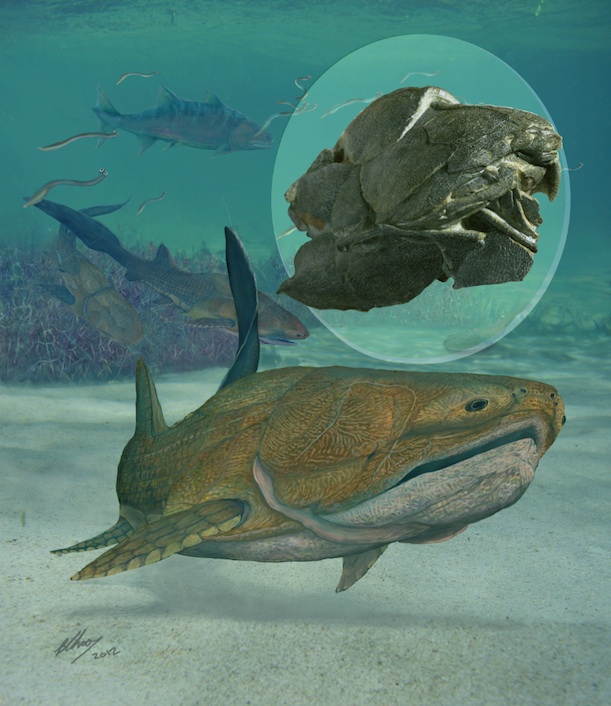This 419-Million-Year-Old Fish Has the World’s Oldest Known Face
The ancient fossil, just discovered in China, could upend our understanding of how all vertebrates evolved over time
/https://tf-cmsv2-smithsonianmag-media.s3.amazonaws.com/filer/20130925121149fossil-copy.jpg)
Sure, it’s not much to look at. But stare long enough, and you’ll see a jaw (jutting out towards the right), a pair of nostrils (small perforations directly above the mouth cavity) and even a tiny eye socket (just above the mouth, to the left of the nostrils, staring out sideways).
This admittedly homely fish fossil, the 419-million-year old Entelognathus primordialis, was recently discovered in China and described for the first time in an article published today in Nature. What makes it remarkable is everything that’s come after it: It’s the oldest known creature with a face, and may have given rise to virtually all the faces that have followed in the hundreds of millions of years since, including our own.
The uncommonly well-preserved, three-dimensional fossil, analyzed by a group of researchers from the Chinese Academy of Sciences, was excavated near Xiaoxiang Reservoir in Southeast China, in a layer of sediment that dates to the Silurian period, which ranged from roughly 419 to 443 million years ago. All other fish specimens from this era are jawless fish (a group of more primitive creatures that still live on today as lampreys and hagfish), so this is the first one that has what we might call a face: a mouth, nose and two eyes.
It’s difficult to conclude very much about the behavior or lifestyle of the ancient creature, but we do know that it swam in water (land animals didn’t begin to evolve until the Devonian period, which spanned 359 to 419 million years ago) and was likely a top-level predator of the early ocean ecosystem.
What has scientists so excited, though, is that the particular anatomical features of this fossil could upend our understanding of how vertebrates evolved over time. “When I first saw this, I was completely blown away,” says Matt Friedman a paleobiologist at the University of Oxford that reviewed the paper and wrote an accompanying article in Nature. “It’s the kind of fossil you might see once or twice in your lifetime, as a research scientist.”
Friedman and others find the fossil so remarkable because it combines a series of characteristics from two different groups: placoderms, an ancient class of armored fish that went extinct millions of years ago, and bony fish, a lineage that gave rise to all modern fish with jaws and bone skeletons. Previously, it was assumed that placoderms died out completely (and that the other, more recent types of fish with similar armor plating had independently re-evolved it much later), while a different, shark-like group of fish called acanthodians led to the bony fishes.
“What a fossil like this shows is that maybe that’s not the case,” Friedman says. “Because if you look at just the top of the skull and the body, it looks like a placoderm. But when you look at the side, and the front, you see it has jaws that, bone for bone, closely resemble the jaws of bony fish.”
This is significant because of what happened next: bony fish gave rise to all modern vertebrate fish, along with all amphibians, reptiles, birds and mammals, including ourselves. In other words, this fossil might mean that the placoderms didn’t go extinct, but rather evolved into the tremendous diversity of animals that live on both land and sea—and that this ancient, strange-looking face belongs to one of your oldest ancestors.
Scientists won’t immediately jump to reorganize their evolutionary family trees overnight, but the new finding will prompt a period of renewed scrutiny of the previous model. “It’s going to take a while for people to digest it and figure out what it all means,” Friedman says. “From a fossil like this, you’ve got a cascade of implications, and this is just the first paper to deal with them.”
Eventually, though, this finding could help transform our understanding of just how evolution occurred in our planet’s ancient oceans—and how the primitive creatures that swam in them eventually gave rise to the faces we see everyday.
/https://tf-cmsv2-smithsonianmag-media.s3.amazonaws.com/accounts/headshot/joseph-stromberg-240.jpg)

/https://tf-cmsv2-smithsonianmag-media.s3.amazonaws.com/accounts/headshot/joseph-stromberg-240.jpg)